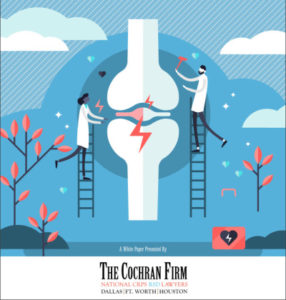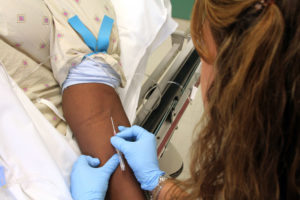Suffering from Complex Regional Pain Syndrome, What’s Next

Are you suffering from complex regional pain syndrome (CRPS)? If you have been living with excessive pain for more than six months and are experiencing changes in skin color, temperature and swelling in a certain part of your body following an injury, this may be the case. There is no simple test to quickly diagnose CRPS, and it may take your physician some time to determine if you have it. But, if you happen to get a CRPS diagnosis, the sooner you seek treatment the quicker you can see improvements to your symptoms.
While there is no cure or quick fix to CRPS, often a combination of different medications and therapies can help relieve some of the painful physical conditions associated with CRPS.
What medications can help treat CRPS?
Unfortunately, there is no single drug specifically designed for CRPS that is approved by the U.S. Food and Drug Administration (FDA). However, there are several types of medications that have been effective in alleviating CRPS symptoms. Before starting any kind of drug treatment for CRPS, make sure you work with a healthcare professional to determine what would be best for your individual situation.
Some drugs that are used to treat CRPS include:
- Pain relievers such as aspirin, ibuprofen and naproxen. Opioids such as oxycodone, morphine, hydrocodone and fentanyl may also be prescribed but must be monitored under the close supervision of a physician, as these drugs may be addictive.
- Bone loss medications may help prevent the loss of bone density.
- Corticosteroids such as prednisone can treat inflammation and swelling.
- Antidepressants and anticonvulsants can be effective for neuropathic pain.
- Botox (Botulinum toxin injections) can reduce muscular hyperactivity and reduce pain.
- N-methyl-D-aspartate (NMDA) receptor antagonists, which are a class of anesthetics that work to stop the action of the N-methyl-d-aspartate receptor. This receptor allows for the transfer of electric signals between neurons in the brain and in the spinal column.
- Ketamine (topical, oral, low dose, or high dose) is a powerful anesthetic that has shown great promise for pain relief.
- Topical local anesthetic creams and patches such as lidocaine may reduce hypersensitivity.
What else can help those suffering from CRPS?
In addition to medications, there are a variety of therapies that can help improve CRPS symptoms. Some of the therapies that the National Institute of Neurological Disorders and Stroke (NIH) and the Mayo Clinic recommend include:
- Rehabilitation, physical and occupational therapy. It’s important to keep the affected limb moving to improve blood flow and lessen any circulatory symptoms. This can also help improve flexibility, strength and function. Occupational therapy can teach you new ways to work and perform daily tasks.
- Heat therapy. Applying heat may offer relief of swelling and discomfort on the skin that feels cool.
- Transcutaneous electrical nerve stimulation (TENS). Chronic pain is sometimes eased by applying electrical impulses to nerve endings.
- Relaxation techniques such as biofeedback, progressive muscle relaxation and guided motion/mirror therapy can alleviate pain.
- Spinal cord stimulation. Tiny electrodes are inserted along your spinal cord. A small electrical current is delivered to the spinal cord and can offer pain relief.
- Intrathecal drug pumps send medications that relieve pain into spinal cord fluid.
- Acupuncture. The insertion of long, thin needles may help stimulate nerves, muscles and connective tissue to increase blood flow and relieve pain.
- Sympathetic nerve block involves injecting an anesthetic next to the spine to directly block the activity of sympathetic nerves and improve blood flow. It can offer temporary pain relief, but there is no published evidence of long-term benefit.
In addition to the above-mentioned medications and therapies, a service animal can also be a beneficial addition to your CRPS treatment plan. And, don’t forget to manage your mental wellness. Feelings of anger and frustration are common emotions associated with CRPS so incorporating a therapist, psychologist or other professional to teach coping skills and relaxation techniques are necessary. It’s also important to maintain normal daily activities and continue to pursue activities that you enjoy and are able to do at your own pace.
Emerging treatments and studies for CRPS
Medical research is being done around the world to find new ways to limit the painful and sometimes disabling symptoms of CRPS. According to the NIH, research has shown that CRPS-related inflammation is caused by the body’s own immune response. So researchers hope to better understand how CRPS develops by studying immune system activation and peripheral nerve signaling using an animal model of the disorder.
A research study conducted by a team of international researchers is also studying the possibility of immune response treatments for CRPS. The researchers examined antibodies in the serum of patients with CRPS symptoms lasting more than a year and who did not respond well to drug therapy. They wanted to figure out the potential role of these patients’ proteins in causing CRPS symptoms. The researchers transferred the antibodies from patients with long-lasting CRPS to mice and found that these antibodies consistently caused a CRPS-like condition.
Dr. Andreas Goebel of the University of Liverpool’s Pain Research Institute who is leading the study, said, “Our results support previous clinical observations that patients with persistent CRPS should respond to immune treatments with a reduction of at least some of their disease features.” He added, “This approach has attractive therapeutic potential and could also have a real impact on the treatment of other unexplained chronic pain conditions.”
The NIH also believes that limb trauma, such as a fracture, followed by immobilization in a cast, is the most common cause of CRPS. By studying an animal model, researchers hope to better understand the neuroinflammatory basis of CRPS in order to identify the relevant inflammatory signaling pathways that lead to the development of post-traumatic CRPS. They also will examine the inflammatory effects of cast immobilization and exercise on the development of pain behaviors and CRPS symptoms.
With continued medical research on the horizon, there is hope for those suffering from CRPS. If you have CRPS or think you might be developing this condition, make sure to seek medical attention as soon as possible. In some cases, CRPS can go away on its own, but in others, painful symptoms can last for years. Getting an early diagnosis and starting on a treatment plan quickly is the key to a better CRPS outcome.



